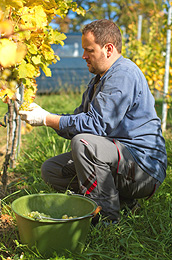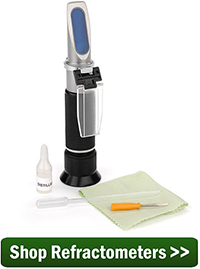 Knowing the optimum time to pick your grapes for wine is a crucial skill that must be mastered before any vineyard can become successful, yet the “knowing when” seems to be the one thing that eludes many amateur vintners.
Knowing the optimum time to pick your grapes for wine is a crucial skill that must be mastered before any vineyard can become successful, yet the “knowing when” seems to be the one thing that eludes many amateur vintners.
What’s At Stake
The timing of the harvest plays a serious roll in the resulting wine. Basic features such as flavor, acidity, body, color, as well as stability are all tied to this decision. One should think of the harvest timing as the first decision to be made in the wine making process.
The Goal
Grapes are no different than most fruits on the face of this earth. As they mature through the growing season, they go from small and tart to big and sweet. In general, we want the grapes to be as sweet as possible but without risking the loss of too much acidity or acidic strength.
The sugars are what the yeast ferment into alcohol. The more sugars there are in the grape juice the more alcohol you will have from the fermentation, so we always want more sugar. But we also don’t want the acidic concentration and strength to deplete too much. This will cause the wine to be less stable and less likely to be able to protect itself from flavor deterioration, loss of color intensity, and potentially spoilage. We also don’t want the wine to be too acidic. This will make the wine too tart or sharp in flavor.
The Tools
 As a vintner there are three key pieces of equipment that are necessary to determine the when to pick your grapes: a refractometer, an acid titration kit, and a pH meter. Refractometers measure the amount of sugar in the juice. An acid titration kit measures the amount of the acid in a juice. The pH meter measures the strength of the acid in the grape juice.
As a vintner there are three key pieces of equipment that are necessary to determine the when to pick your grapes: a refractometer, an acid titration kit, and a pH meter. Refractometers measure the amount of sugar in the juice. An acid titration kit measures the amount of the acid in a juice. The pH meter measures the strength of the acid in the grape juice.
I would also strongly recommend getting a wine hydrometer for doing a final check of sugar levels before actually picking the grapes. The hydrometer actually floats in the juice to determine the Brix level. Having a wine hydrometer will also be handy later on when you’re actually making the wine.
Read More >>
Part I: The Importance Of Timing
Part II: Taking Reading
Part III: What Readings To Expect
Part IV: The Big Compromise
—–
Ed Kraus is a 3rd generation home brewer/winemaker and has been an owner of E. C. Kraus since 1999. He has been helping individuals make better wine and beer for over 25 years. #picking

This will be one of the most important series of articles. Thank you, Ed, and keep up the fantastic work!
We have Concord and Catawba grapes. We live in the northern IL area. Timing… Each year is always different for us. Sometimes as we are waiting for the grapes to get sweeter on the vines… they start to fall off. Some are ready sooner then others. It’s frustrating!
Good stuff just starting a vineyard that is only three years old this is a major issue. This was a strange year Birds, wind storms, and lack of rain.
As I say next year will be a better year! Cheers I read every article you write and I archive them!Thanks
this is awesome just what I need to know. look forward to part 2.
Hello Ed,
What to do when you harvest late and the sugar level is too high? How can you add acidity? Or it’s too late
Thank you
Oscar, both the sugar and the acid can be adjusted before fermentation begins. If the juice is too high in sugar or acid, the addition of water will lower both the sugar and acid level. If the acid level is too low, you can add ACID BLEND to bring it up. Below you will find a link that will explain this and also walk you through the process of making wine with grapes.
Making Wine With Grapes
http://www.eckraus.com/wine-making-grape
Unfortunately for me, timing is based on the birds. I would love to wait until proper Refractometer level but when birds make a steady habit of invading my 6 plants I start harvesting all but the small hard immature. Gave up on bird net after 1st year it had to be cut away from the vines.
As of September 4th my Frontenac are at 18-22 Brix depending on the location in the rows and cluster positioning. I want to wait till end of September to harvest. Weather is on the cool side, no bird issues and no bees. Ideal eh! But how much more will the Brix increase in three weeks? I can add water to amerolate.
Barry, unfortunately, there are too many environmental variables to predict what the brix may be. We would suggest just keep testing so you will know when the time is right to pick.